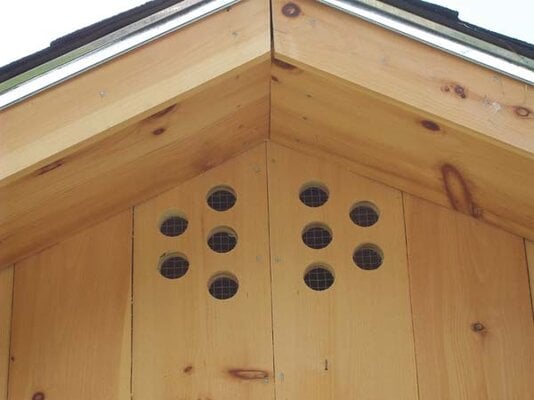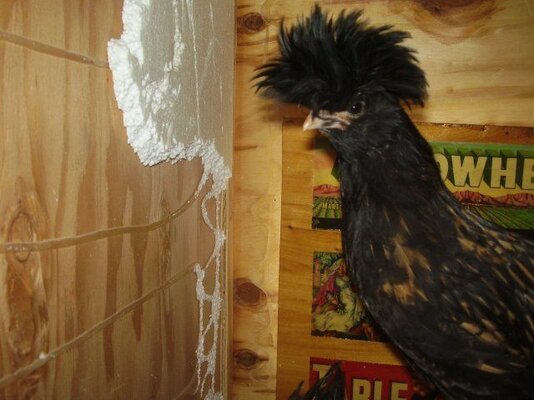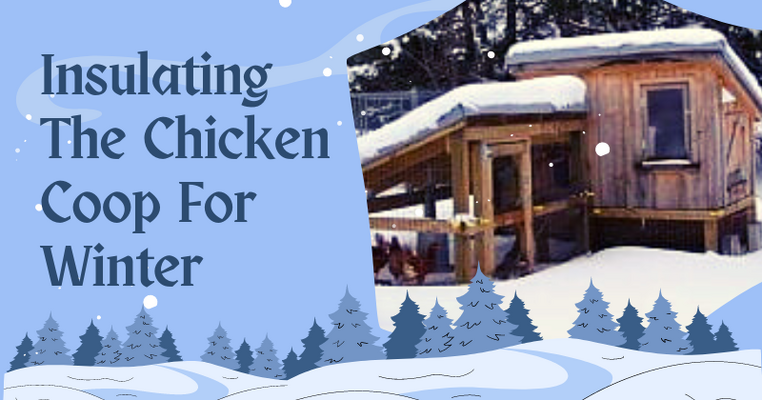There is no doubt that backyard chickens are tough animals that can live in some of the most challenging situations. It is necessary, however, to provide some assistance to the birds during the harsh freezing winter months. While raising chickens during the winter can seem challenging, it is not as difficult as you may think. Cold-hardy breeds of chicken are better able to regulate their body temperature naturally.
Adult chickens prefer a temperature range of 70 to 75 degrees Fahrenheit. In cold weather, their internal temperature can be self-regulated. They can also share warmth in the cold by huddling together due to their feathers, which act as insulators.
Even though chickens have the capacity to keep themselves warm, they may need some assistance in the biting cold. Insulating your coop is a good option in this case.
You can learn more about the insulation of chicken coops by reading the following tidbits.
When it is cold, well-insulated coops can provide significant warmth, and even keep birds cool during the summer. Humidity in a chicken coop can also be controlled by insulation.
For your flock to remain disease-free and produce eggs, keeping the right humidity & moisture levels is essential. Therefore, insulation is not just for cold climates.

To prepare your chicken coop for winter, follow these steps.
In order to prevent your insulation material from being pecked at by chickens, you cannot leave it exposed. Insulation material can be hidden with interior paneling.
Keep the chill out by blocking all holes with plywood, cardboard & other sturdy materials. Having a drafty coop will make your insulation ineffective. The door of the coop can be closed on bitterly cold days in order to prevent drafts. Sufficient food & water should be available for them.
The top edge of your coop, where the walls and roof meet, is often where the ventilation happens. Drafts come from cracks in your structure. For your birds to avoid lung problems caused by the build-up of ammonia during the winter, ventilation is crucial.
The wall near the ceiling of your coop can be drilled with a few small holes on opposite sides. By doing so, the flock is kept healthy and air flows freely through the enclosure.

This may be desirable for you. In the late summer you don't have to sweep your used chicken bedding or remove it. When the coop starts to smell of old litter, cover it with 1-3 inches of wood shavings. To generate enough bedding depth and heat for the winter, continuously add wood shavings without removing the used bedding.
Your coop will stay clean and fresh while the deeper bedding layers are composting as each layer of bedding insulates the air from the odors beneath. Over time, bedding accumulates. As composting begins, the bottom layers begin to generate heat.
The decomposition of lower bedding layers is facilitated by the warmth of the upper layers and the nitrogen found in chicken waste. As a result, heat is generated that rises into the coop and warms it. As long as the upper layers of bedding are thick and fresh, the odor in your enclosure will not be affected. The bedding can be raked out during spring and then accumulated again.
You should also place the roost on the warmest side of your coop. By doing this, they are protected against bitter winds that may stir up during the night.
If you don't cover it with paneling, the birds will peck at it, but they usually lose interest after a short period of time. If you live in a place where winters are harsh, it may not be the best choice.
To properly insulate your chicken coop, you might have to stack several stacks of cardboard, which will result in thick walls and a small coop.

Because Styrofoam is easy to install, lightweight, and provides exceptional insulation, it is one of the best materials for insulation. Styrofoam sheets 1.5 inches thick can be used between ceiling & roof, as well as between wall & siding.
If the Styrofoam is not covered, chickens might peck at it and eat it. Since the material is non-toxic, the birds can pass it out in their feces without getting hurt. More on this topic here: Can Chickens Eat Styrofoam?
For the run, you can use hay & straw. Make sure you provide your birds with just enough of these materials to make them want to venture outside their warm coops and stretch their legs.
Further Reading:
Adult chickens prefer a temperature range of 70 to 75 degrees Fahrenheit. In cold weather, their internal temperature can be self-regulated. They can also share warmth in the cold by huddling together due to their feathers, which act as insulators.
Even though chickens have the capacity to keep themselves warm, they may need some assistance in the biting cold. Insulating your coop is a good option in this case.
You can learn more about the insulation of chicken coops by reading the following tidbits.
Should You Insulate A Chicken Coop?
Having a chicken coop insulated is a good idea if you live in a cold climate. As far as insulation is concerned, it is primarily intended to prevent cold wind chill from entering the enclosure while minimizing the transfer of heat outside. During the cold months, your chickens will be more comfortable and happy.When it is cold, well-insulated coops can provide significant warmth, and even keep birds cool during the summer. Humidity in a chicken coop can also be controlled by insulation.
For your flock to remain disease-free and produce eggs, keeping the right humidity & moisture levels is essential. Therefore, insulation is not just for cold climates.
Winterizing your chicken coop
To prepare your chicken coop for winter, follow these steps.
Insulate the Roof & Walls
It is not necessary to have fancy insulation for your bird's coop's walls and roof. You can insulate your coop with the following materials:- Recycled or scrap materials: Local hardware stores typically have some overstocked and used building materials that you can purchase. You can find insulation at lumber yard resale shops for 80-90% less than you would pay at a retailer when it is leftover from large projects.
- Styrofoam that has been repurposed: Styrofoam sheets are relatively easy to reuse, even though they are difficult to recycle via traditional methods.
- Cardboard boxes or cartons: When your chicken coop is drafty, this is effective at blocking crosswinds. You can tape the cardboard to the coop's walls, but you should monitor it carefully because it is flammable and can get wet.
- If you are on a tight budget, you can use thick fabric like old towels or curtains to insulate your chicken coop.
- Spray foam: Even though it is expensive, it is the best choice for insulating your chicken coop. Professional installation may also be required.
In order to prevent your insulation material from being pecked at by chickens, you cannot leave it exposed. Insulation material can be hidden with interior paneling.
Winter drafts should be blocked
To keep warm in the winter, chickens puff their feathers to create warm pockets of air between their skin and feathers. The birds will feel a chill if there is a draft that disrupts this warm air pocket. Your chicken coop should be regularly monitored to check for gaps or holes that might allow a chilling breeze to enter.Keep the chill out by blocking all holes with plywood, cardboard & other sturdy materials. Having a drafty coop will make your insulation ineffective. The door of the coop can be closed on bitterly cold days in order to prevent drafts. Sufficient food & water should be available for them.
Ventilation is essential
A few poultry keepers mistake ventilation for drafts. With ventilation, fresh air is intentionally introduced into a room, while drafts are air currents drawn into it.The top edge of your coop, where the walls and roof meet, is often where the ventilation happens. Drafts come from cracks in your structure. For your birds to avoid lung problems caused by the build-up of ammonia during the winter, ventilation is crucial.
The wall near the ceiling of your coop can be drilled with a few small holes on opposite sides. By doing so, the flock is kept healthy and air flows freely through the enclosure.
Deep Bedding
Your chicken coop can be heated by composting manure warming it up by about fifteen degrees over time.This may be desirable for you. In the late summer you don't have to sweep your used chicken bedding or remove it. When the coop starts to smell of old litter, cover it with 1-3 inches of wood shavings. To generate enough bedding depth and heat for the winter, continuously add wood shavings without removing the used bedding.
Your coop will stay clean and fresh while the deeper bedding layers are composting as each layer of bedding insulates the air from the odors beneath. Over time, bedding accumulates. As composting begins, the bottom layers begin to generate heat.
The decomposition of lower bedding layers is facilitated by the warmth of the upper layers and the nitrogen found in chicken waste. As a result, heat is generated that rises into the coop and warms it. As long as the upper layers of bedding are thick and fresh, the odor in your enclosure will not be affected. The bedding can be raked out during spring and then accumulated again.
Roosting should be adjusted
Warm feet are a comfort for chickens on cold nights, just as they are for people. Additionally, they snuggle close together to keep warm. For your birds to stay warm in winter, ensure your roost is large and solid.You should also place the roost on the warmest side of your coop. By doing this, they are protected against bitter winds that may stir up during the night.
What is the cost of insulating a chicken coop?
Insulating your chicken coop does not have a set price. In terms of costs, you will need to consider materials and whether to hire a professional or handle it yourself. Use recycled materials or repurpose a few items, such as old blankets, to reduce your insulation budget.Does cardboard work as an insulator for chicken coops?
You can insulate your chicken coop with cardboard. This insulation material is easy and inexpensive to repurpose from packaging. Therefore, instead of dumping cardboard insulation in landfills, you will contribute to the conservation of the environment.If you don't cover it with paneling, the birds will peck at it, but they usually lose interest after a short period of time. If you live in a place where winters are harsh, it may not be the best choice.
To properly insulate your chicken coop, you might have to stack several stacks of cardboard, which will result in thick walls and a small coop.
Does Styrofoam work well as chicken coop insulation?
Because Styrofoam is easy to install, lightweight, and provides exceptional insulation, it is one of the best materials for insulation. Styrofoam sheets 1.5 inches thick can be used between ceiling & roof, as well as between wall & siding.
If the Styrofoam is not covered, chickens might peck at it and eat it. Since the material is non-toxic, the birds can pass it out in their feces without getting hurt. More on this topic here: Can Chickens Eat Styrofoam?
Conclusion
Using the information above, you can insulate your chicken coop effectively and confidently. Keep your chickens happy and healthy even in the winter by allowing them to enjoy some fresh air. In order to protect your chickens' wattles, combs, and feet from frostbite, you should add an extra layer of insulation to their run.For the run, you can use hay & straw. Make sure you provide your birds with just enough of these materials to make them want to venture outside their warm coops and stretch their legs.
Further Reading:




